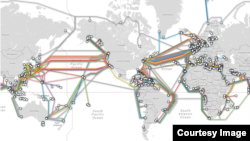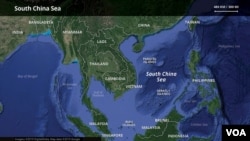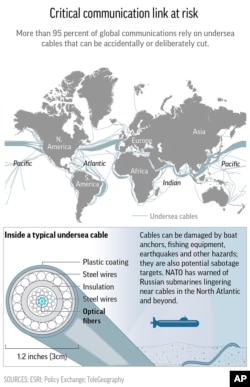A new source of tension in the South China Sea — until now focused on fisheries, resource extraction and freedom of navigation — is beginning to get attention: the undersea fiber-optic cables that crisscross the strategic waterway and carry almost all of the region's internet and other telecommunications traffic.
Since 2020, according to published reports, the United States has been urging countries in the region to avoid using a Chinese company to repair or lay new cables at the bottom of the sea out of concern that China could intercept and monitor sensitive communications passing through the cables.
It has also been urging companies to route new cables around the perimeter of the sea, avoiding the central part of the waterway claimed by China based on historic maps showing a 10-dash line that infringes on the exclusive economic zones of several other countries.
In what may be an act of retaliation, according to a Washington Post report this month, China has been delaying — sometimes for months — its approval of permits for companies to repair or lay new cables under the sea. The delays have been particularly troublesome for countries such as Vietnam, which is anxious to replace five aging cables that have failed repeatedly, slowing internet traffic in the country.
In the past four years, the U.S. government has blocked at least three cable projects that would have linked the United States to Hong Kong because of concerns that China could spy on or sabotage communications, the Post reported.
Concerns were also raised at last month's U.N. General Assembly meetings, where the U.S. and other countries, including Australia, France, Japan, Singapore, South Korea and the U.K., issued a joint statement calling for undersea cables to be kept secure from risks that included surveillance, intentional damage and compromise of data and communications.
"There is a risk of surveillance and snooping in by the Chinese telecom companies, and similar kind of surveillance risk exists also for undersea cables," said Sameer Patil, director of the Center for Security Strategy and Technology at the Observer Foundation in New Delhi.
The kind of data that the Chinese military could gather in real time through undersea cables includes information about U.S. military personnel, the movement of U.S. naval warships and other military assets, Patil told VOA.
Although the U.S. and some other countries have undersea cables that are exclusive for military use, countries in the Indo-Pacific do not have the financial means to maintain dual sets of cables, said Patil, who is based in Mumbai and has been closely following the issue.
This means these countries may transmit sensitive military data and civilian data over the same sets of cables, he said.
At the center of the concerns is China's HMN Technologies, the latest entrant into the specialized field of cable laying that previously was dominated by just three companies: U.S.-based SubCom, French firm Alcatel Submarine Networks and Japan's Nippon Electric Company.
HMN Technologies was once owned by Huawei and is still considered by the U.S. to be an affiliate of the Chinese tech giant, whose equipment has been banned in the United States and other countries over fears that it can be used to facilitate Chinese espionage.
Reuters news agency reported exclusively last month that the United States is pressing Vietnam to avoid using HMN Technologies in its plans to build 10 new undersea cables by 2030. It said U.S. officials and companies have held at least a half-dozen meetings with Vietnamese and foreign officials and business executives on the matter this year.
Reuters also quoted multiple sources saying U.S. officials have separately shared intelligence about possible sabotage of Vietnam's subsea cables.
The Post said concerted U.S. lobbying has led to three other U.S.-financed transpacific cable projects being routed through the coastal waters of Indonesia and the Philippines to avoid Beijing-claimed waters, driving up the costs of the projects.
Meanwhile, according to executives at seven cable companies cited by the Post, permits for cable work that were once approved by China in less than 10 days now are taking up to four months and are sometimes rejected with little justification.
While China's claim to most of the South China Sea has been rejected by an international tribunal, the companies say they are unwilling to risk working in the area without Beijing's approval.
"What we're seeing is China essentially retaliating by delaying permits that it can grant," said Elisabeth Braw, a senior fellow at the Atlantic Council's Scowcroft Center for Strategy and Security.
"The U.S. government is concerned about China listening in on existing cables," and Beijing is retaliating against the U.S. for trying to dissuade countries from using Chinese companies, Braw told VOA.
Beijing rejected that interpretation in response to questions this week from VOA.
"The Chinese government has always welcomed and supported the laying of international submarine cables by other countries and telecommunications companies in waters under China's jurisdiction," said Liu Pengyu, a spokesperson for the Chinese Embassy in Washington.
"Over the years, China has actively promulgated relevant laws and regulations to clarify the rights and obligations of all countries to lay submarine cables in waters under China's jurisdiction" to "provide a sound legal guarantee for the transit of international submarine cables in waters under China's jurisdiction," he said.
Erin Murphy, a senior fellow for the Asia Program at the Center for Strategic and International Studies in Washington, told VOA that China may have its own concerns about espionage or sabotage operations when cable-laying ships from the United States or other Western countries operate in areas it claims as being under its jurisdiction.
"There's also the economic competition angle. Preventing non-Chinese companies from operating in their perceived backyard is one way to continue to dominate the network, providing ongoing business for its companies and fulfill its digital Silk Road ambitions," she said.
Braw at the Atlantic Council said Chinese companies, while relatively new to the field, have become highly competitive with Western cable-laying companies by offering to build and repair subsea cables at cheaper costs.
An estimated 400 to 600 fiber-optic cables crisscross the world's seabed with a total length of 1.4 million kilometers, according to TeleGeography, a research firm monitoring the telecommunications industry. That is enough to wrap around the earth's circumference about 35 times.
These cables carry more than 95% of global data, including voice communications, according to the National Oceanic and Atmospheric Administration of the U.S. Commerce Department.













